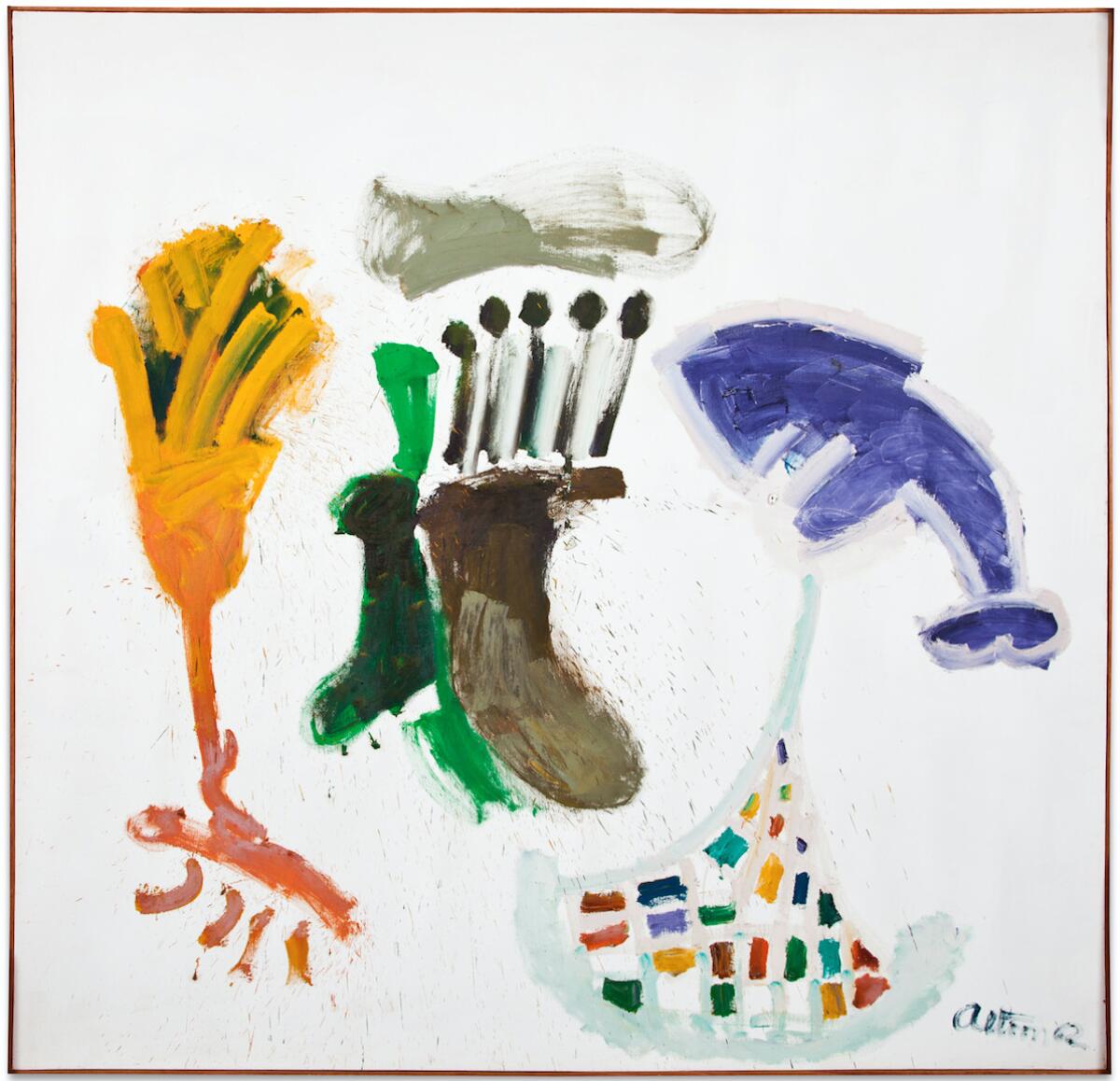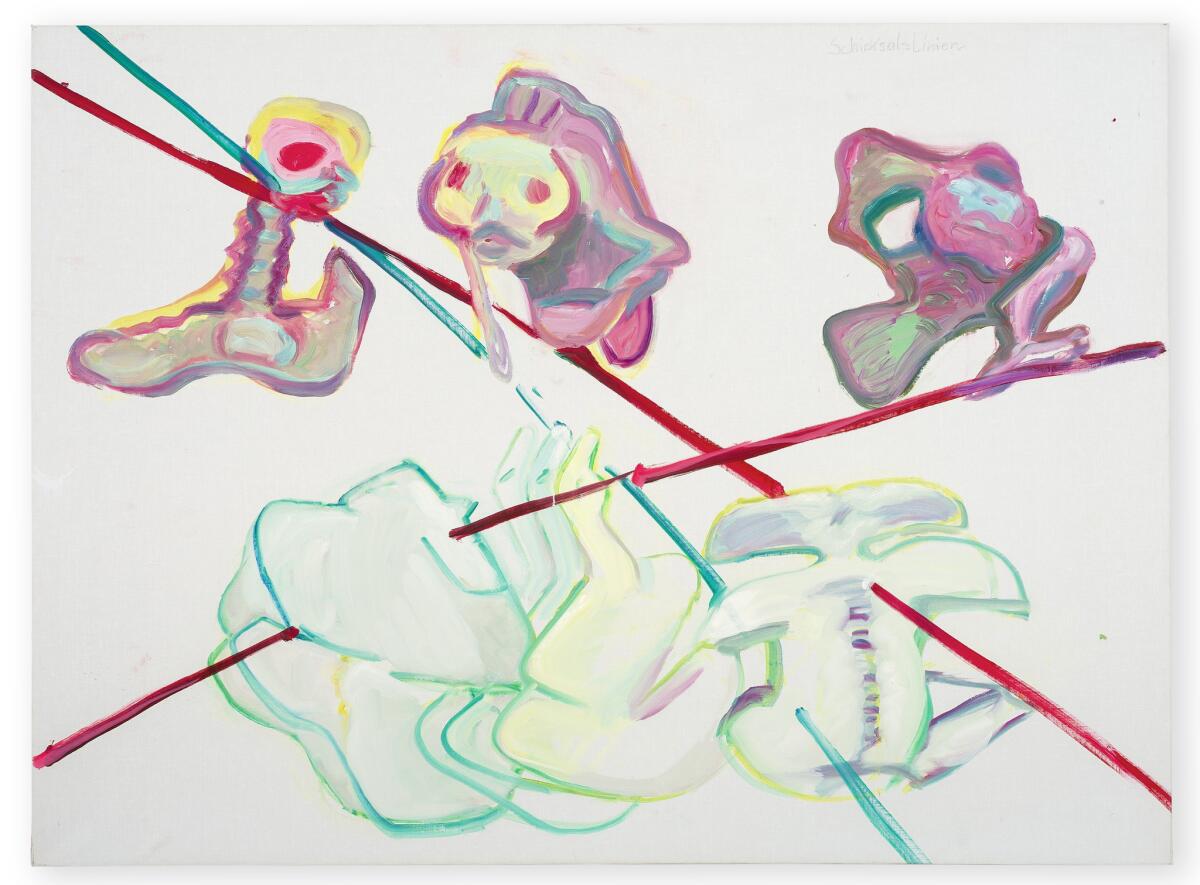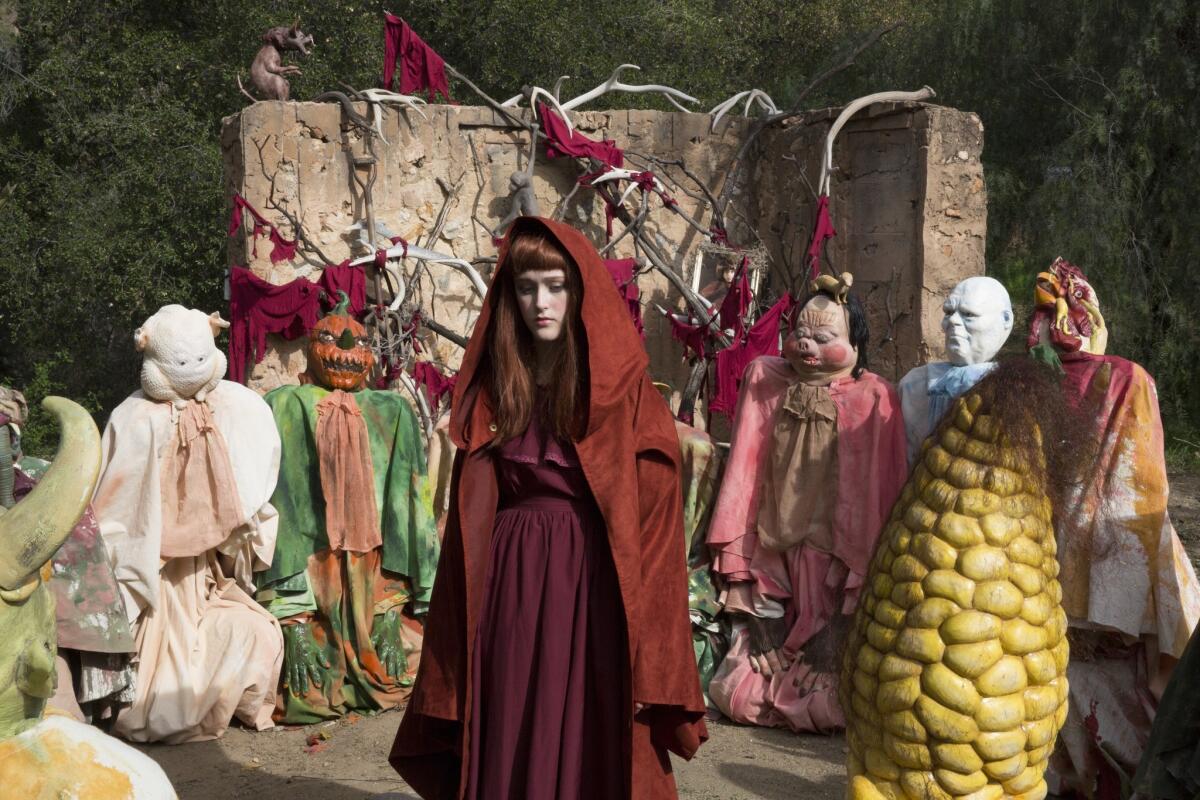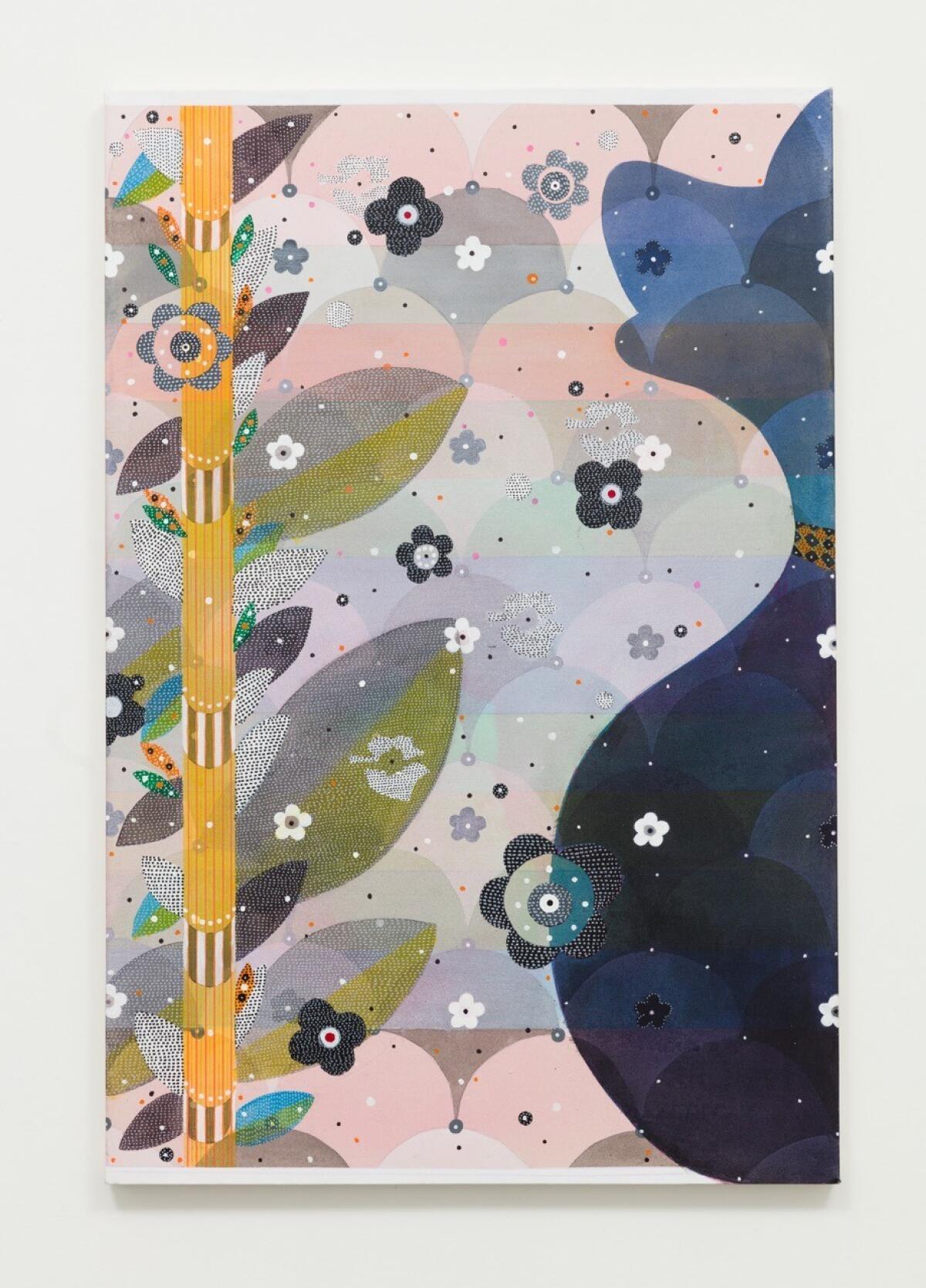What to see in L.A. galleries: John Altoon, Maria Lassnig, a funky fairy tale and stenciled magic
Although John Altoon died in 1969, when he 43, his paintings and drawings look as fresh as the day they were made. They may, in fact, be even fresher.
The rambunctious loveliness that was Altoon’s stock in trade is served up in abundance at Kohn Gallery, where 11 paintings on canvas and board and 18 works on paper — all made from 1958 to 1968 — have been beautifully installed.

Raw, jaw-dropping talent spills from the surfaces Altoon touched, except for a few early canvases, painted before he had worked the formulaic maneuvers of academic expressionism out of his system and came, face to face, with his own whiplash facility.
In one fell swoop, Altoon seems to have discovered that the sexiest art unfolds in the imagination. There’s little that’s very explicit in his best compositions. But each seems salacious, not quite pornographic, but far too steamy to be suited for anyone’s living room.
It’s difficult to articulate just what makes Altoon’s paintings so lusty — and lust-worthy. But that’s part of the fun. As soon as you say what you see in his abstract configurations of swollen blobs, probing protuberances and welcoming crevasses, you feel that your words exaggerate the playful relationships that unfold in his elusive images.
Altoon takes viewers back to Surrealism by way of spray-paint and comic strip figuration. His works make so much room for the imagination that it’s all but impossible to exhaust the visual acrobatics — and intellectual gymnastics — of his shape-shifting pictures. Hedonism never looked better, nor made for such long-lasting satisfactions.
John Altoon, Kohn Gallery, 1227 N. Highland Ave., Los Angeles. Through Oct. 29; closed Sundays and Mondays. (323) 461-3311, www.kohngallery.com

“Maria Lassnig. A Painting Survey, 1950-2007” fills five handsome galleries at Hauser Wirth & Schimmel in downtown Los Angeles with just the right number of paintings (31) to give visitors terrific insight into the Austrian artist’s commitments and strengths.

Laser sharp and evocative, the efficient exhibition paints a picture of an artist who plowed through styles and subjects to create paintings that make us grapple with our emotions about our bodies and souls. You leave wanting more, deeply satisfied by what you have seen and driven by the desire to see even more deeply.
Organized by Peter Pakesch, chairman of the Maria Lassnig Foundation in Vienna, and Paul Schimmel, the former Museum of Contemporary Art chief curator and now a partner in the gallery, the survey shows Lassnig (1919-2014) dredging the best out of hard-edged abstraction, gestural expressionism, cartoon figuration and lumpen self-portraiture. Sometimes she mixes seemingly antagonistic approaches. At others she strips painting to its essentials: raw emotion, naked sensation and heart-wrenching revelation.
Superficial differences fall away as you discover fundamental similarities. Lassnig had the capacity to make emptiness sing — to make the space between objects and figures bristle with energy.
Her crudely rendered figures are even more potently loaded. Each seems sentient. Plagued by pain yet unwilling to complain, Lassnig’s beastly creatures stand out from the navel-gazing narcissism of the present.
Self-reflection, not self-aggrandizement, was her goal and modus operandi. There’s great excitement to be had before her paintings, which take visitors on roller-coaster rides that leave you feeling wrung out and enlightened — and restless to go again.
------------
Maria Lassnig, Hauser Wirth & Schimmel, 901 E. 3rd St., Los Angeles. Through Dec. 31; closed Mondays and Tuesdays. (213) 943-1620, www.hauserwirthschimmel.com

The centerpiece of Marnie Weber’s mixed media installation at Gavlak in Los Angeles is a feature film written by, directed by and starring Weber, who also built the sets, designed the costumes, did the makeup and gave birth to the heroine of the funky fairy tale. Weber’s teenage daughter, Colette Weber Shaw, plays Crimson Luna, a teenage witch who yearns to escape the suffocating grip of her overbearing mother, Baba Muthra, played by Weber.
Both are fantastic, each in her own way. And so is “The Day of Forevermore,” whose haunting tone, drifting pace and dreamy atmosphere combine elements of “A Midsummer Night’s Dream,” “The Wizard of Oz,” “Donnie Darko,” “Little Red Riding Hood” and “The Nightmare Before Christmas.”
Into the felicitous mix of influences, Weber stirs Mardi Gras, the Brothers Grimm, Maurice Sendak and Ken Kesey. Her eye for endearing weirdness whips such diverse sources into a coming-of-age tale that ricochets between mother and daughter, comedy and tragedy, fantasy and reality. Plan to spend 90 minutes at the exhibition. The seats are comfortable, and Weber’s film builds with each minute, no matter when you start watching.
SIGN UP for the free Essential Arts & Culture newsletter »
Her wonderfully original work is a bittersweet love poem to the pains of growing up and leaving home. It’s also a metaphor for letting go and moving on. It bears compelling witness to the quiet suffering that accompanies the powerlessness of adulthood — especially when things don’t go as planned, regret rears its ugly head and fate’s twists and turns involve children.
A sense of impending doom suffuses each scene. But it’s tempered by the kindness of strange creatures — comical monsters that neither speak nor reveal their identities or purposes. Weber is an expert storyteller. Her métier is suggestiveness. She lets colors, textures, space and time weave a spell of poetic power.
Before you get to the darkened gallery in which the film plays, you walk through an enchanted forest of an exhibition. Titled “Chapel of the Moon,” it includes Halloween-style totem poles, gigantic wind chimes, a tumbling waterfall, a couple of realistic but impossible to believe mannequins and a series of collages, some huge, others intimate.
Weber’s collages steal this part of the show. Like her film, they take a step back from reality to give riveting form to its psychological undercurrents.
------------
Marnie Weber, Gavlak, 1034 N. Highland Ave., Los Angeles. Through Nov. 5; closed Sundays and Mondays. (323) 467-5700, www.gavlakgallery.com

Glenn Goldberg’s new paintings call to mind all sorts of things, including dogs and rubber duckies, as well as beanstalks and rainbows, stars and gingerbread men.
Most of the recollections triggered by Goldberg’s stenciled pictures have to do with childhood, particularly the way in which its innocence is battered by the demands of adulthood.
The New York painter’s wispy depictions of silhouetted figures evoke complex sentiments, but more important is the way they make their way into consciousness. At Charlie James Gallery in Chinatown, each of Goldberg’s paintings has the presence of an afterimage.
Eight midsize acrylics on canvas and 18 small watercolors make up “Somewhere,” Goldberg’s fourth solo show in Los Angeles since 1985. To look at the work is to feel as if you’re seeing the physical imprint your immediate surroundings sometimes leave on your eyeballs — before vanishing, often dramatically. That there-and-gone perception leaves you with the sense that the world is luminous — aglow with a kind of light that may not be tactile but sure feels that way in your retinas.
In Goldberg’s hands, the experience is magical.
The afterimages he paints are gentle and lovely, nuanced and supple. Made up of sun-bleached colors, their rough-cut forms lack the retina-burning buzziness of some optical phenomena. Their off-kilter patterns, soft-focus figures and off-center compositions turn handcrafted intimacy into a sort of storytelling that is inclusive and inspiring.
Glenn Goldberg, Charlie James Gallery, 969 Chung King Road, Los Angeles. Through Oct. 15; closed Sundays and Tuesdays. (213) 687-0844, www.cjamesgallery.com
Follow The Times’ arts team @culturemonster.
ALSO
Berlin photographer's first show in L.A. carries a strange potency
Roy Lichtenstein's love affair with L.A. on view at the Skirball
'Zoot Suit's' Luis Valdez on how Gordon Davidson brought civil rights to the American theater
The biggest entertainment stories
Get our big stories about Hollywood, film, television, music, arts, culture and more right in your inbox as soon as they publish.
You may occasionally receive promotional content from the Los Angeles Times.







